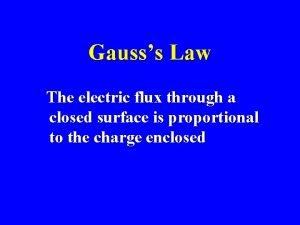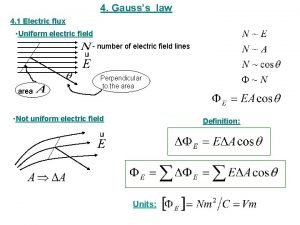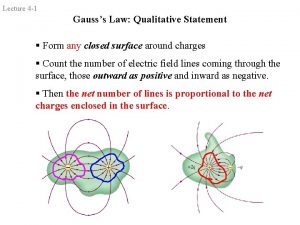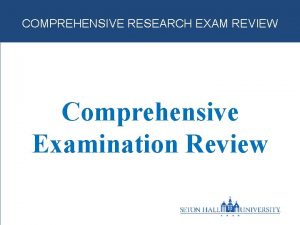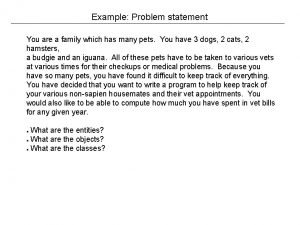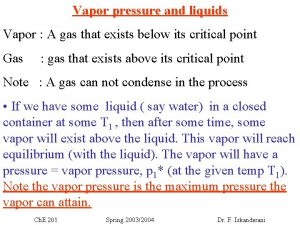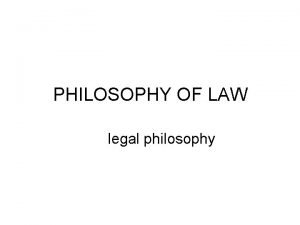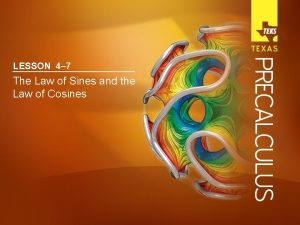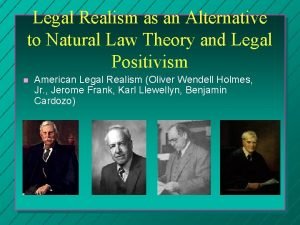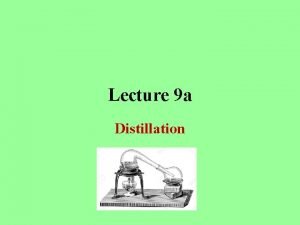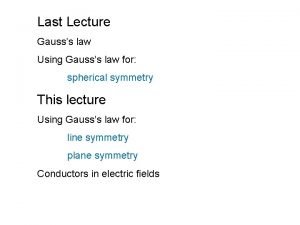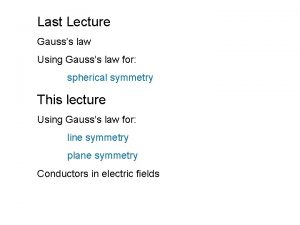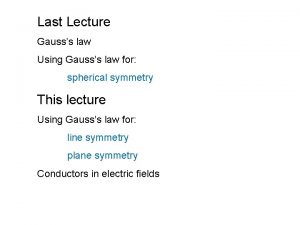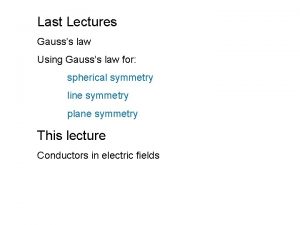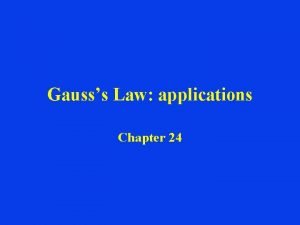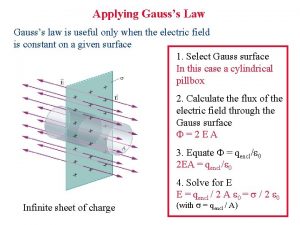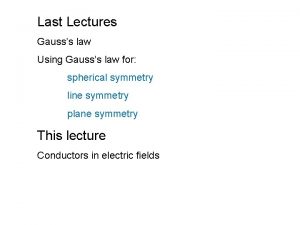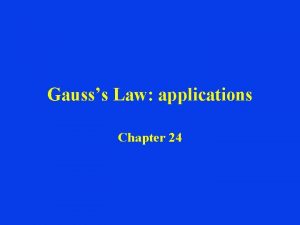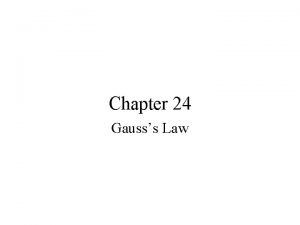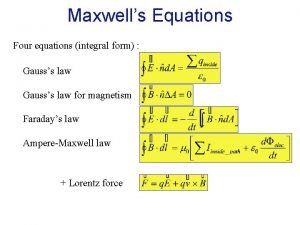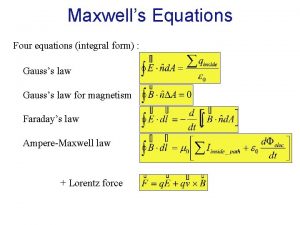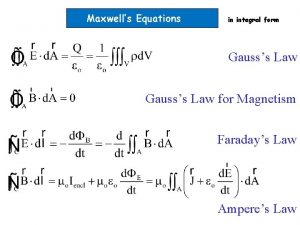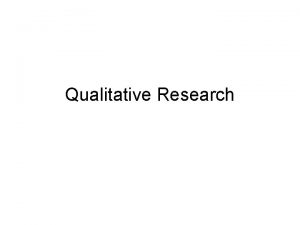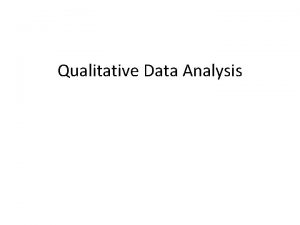Lecture 4 1 Gausss Law Qualitative Statement Form





















- Slides: 21

Lecture 4 -1 Gauss’s Law: Qualitative Statement § Form any closed surface around charges § Count the number of electric field lines coming through the surface, those outward as positive and inward as negative. § Then the net number of lines is proportional to the net charges enclosed in the surface.

Lecture 4 -2 © 2008 by W. H. Freeman and Company

Lecture 4 -3 © 2008 by W. H. Freeman and Company

Lecture 4 -4 © 2008 by W. H. Freeman and Company

Lecture 4 -5 © 2008 by W. H. Freeman and Company

Lecture 4 -6 Reading Quiz 1 Which of the following statements contradict Gauss’s law? a) The electric flux through a closed surface depends on all the charges outside the closed surface. b) The electric flux through a closed surface is proportional to the net charges enclosed in the surface. c) Any closed surface can be used with Gauss’s law. d) An electric dipole inside a closed surface does not change the net flux through the surface.

Lecture 4 -7 Electric flux Summary To state Gauss’s Law in a quantitative form, we first need to compute the Electric Flux. # of field lines N = density of field lines x “area” where “area” = A 2 x cos θ θ Sum over surface General definition of electric flux: (must specify sense, i. e. , which way)

Lecture 4 -8 Electric Flux through a Closed Surface • The integral is over a CLOSED surface. • Since is a scalar product, the electric flux is a SCALAR quantity. • The integration element is a vector normal to the surface and always points OUTWARD from the surface. Out is +. ΦE proportional to # field lines coming through outward

Lecture 4 -9 Gauss’s Law: Quantitative Statement The net electric flux through any closed surface equals the net charge enclosed by that surface divided by 0. How do we use this equation? ? The above equation is TRUE always but it doesn’t look easy to use. BUT - It is very useful in finding E when the physical situation exhibits a lot of SYMMETRY.

Lecture 4 -10 +Q outside a closed surface

Lecture 4 -11 Physics 241 – Warm up Quiz 2 Two identical point charges are placed, at the center of a large sphere in one case, and outside an identical sphere in the other case. Which statement about the net electric flux through the surface of the sphere is true? a) b) c) d) e) The flux is larger when the charge is inside. The flux is larger when the charge is outside. The flux is the same (and not zero). Not enough information to tell. The flux is zero in both cases. Q>0

Lecture 4 -12 Gaussian Surface R © 2008 by W. H. Freeman and Company

Lecture 4 -13 Proof of the Shell Theorem Electric Field Outside a Shell of Charge • By symmetry, the electric field must only depend on r and is along a radial line everywhere. • Apply Gauss’s law to the blue surface , we get

Lecture 4 -14 Uniformly charged thin shell: Inside E = 0 inside • By symmetry, the electric field must only depend on r and is along a radial line everywhere. • Apply Gauss’s law to the blue surface , we get E = 0. • Equal and opposite contributions from charges on diagonally opposite surface elements. Discontinuity in E

Lecture 4 -15 Electric Field of a Uniformly Charged Sphere Apply Gauss’s Law directly or use superposition of the shell results

Lecture 4 -16 DOCCAM 2 GAUSS’S LAW 5 A-12

Lecture 4 -17 Cylindrical coordinates r perpendicular to z axis r 2 = x 2 + y 2 © 2008 by W. H. Freeman and Company

Lecture 4 -18 Line charge λ on z axis © 2008 by W. H. Freeman and Company

Lecture 4 -19 Physics 241 –Quiz 3 10: 30 September 1, 2011 Two identical point charges are each placed inside a large cube. One is at the center while the other is close to the surface. Which statement about the net electric flux through the surface of the cube is true? a) The net flux is larger when the charge is at the center. b) The net flux is the same (and not zero). c) The net flux is larger when the charge is near the surface. d) Not enough information to tell. e) The flux is zero in both cases. +Q +Q

Lecture 4 -20 Physics 241 –Quiz 3 11: 30 September 1, 2011 Two identical point charges are each placed inside a large sphere. One is at the center while the other is close to the surface. Which statement about the net electric flux through the surface of the sphere is true? a) b) c) d) e) The flux is larger when the charge is at the center. The flux is larger when the charge is near the surface. The magnitude of the flux is the same (and not zero). Not enough information to tell. The flux is zero in both cases. +Q +Q

Lecture 4 -21 Physics 241 –Quiz 3 11: 30 September 1, 2011 Two identical point charges are each placed inside and outside a large spherical surface. One is at the center while the other is outside the surface. Which statement about the net electric flux through the surfaces of the sphere is true? a) The flux is larger when the charge is outside the surface. b) The magnitude of the flux is the same. c) The flux is zero when the charge is outside the surface. d) The flux is zero in both cases. +Q +Q
 Gausss law
Gausss law Flux
Flux 01:640:244 lecture notes - lecture 15: plat, idah, farad
01:640:244 lecture notes - lecture 15: plat, idah, farad Newton's first law and second law and third law
Newton's first law and second law and third law Newton's first law of motion
Newton's first law of motion Boyles law
Boyles law Charles law constant
Charles law constant Qualitative purpose statement examples
Qualitative purpose statement examples Qualitative statement
Qualitative statement Qualitative statement of the problem example
Qualitative statement of the problem example Statement of the problem example for qualitative research
Statement of the problem example for qualitative research Present progressive affirmative negative interrogative
Present progressive affirmative negative interrogative Raoult's law and dalton's law
Raoult's law and dalton's law What is a civil law
What is a civil law Programl
Programl Natural law vs positive law
Natural law vs positive law Positive law vs natural law
Positive law vs natural law Law of segregation vs law of independent assortment
Law of segregation vs law of independent assortment Law of sines sss
Law of sines sss Positive law vs natural law
Positive law vs natural law Distillation presentation
Distillation presentation Criminal law plaintiff
Criminal law plaintiff
